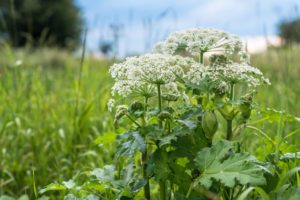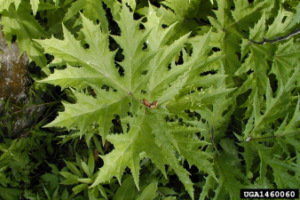Giant hogweed plant (Heracleum mantegazzianum) is a large, invasive plant that can cause severe burns, blisters and rashes and vision loss in humans. As its name suggests, giant hogweed plant is enormous growing invasive species that originated from the Caucasus region of Eurasia. It produces large, towering purple stalks of white flower clusters. Don’t pick these flowers! Contact from its clear watery sap from all parts of giant hogweed (leaves, roots, stems, flowers, and seeds of the plant) results in blisters and rashes in humans. These serious reactions are called “phytophotodermatitis”).
The plant has been found in Canada, Northwestern U.S, New England and mid-Atlantic states, and North Carolina. It is listed among the most serious of invasive weeds. The plant may grow upwards of 15 feet high. Giant hogweed sap contains several photo-sensitizing compounds. Initial symptoms of skin injury after plant contact may not appear for several days. Sap can also burn and blind your eyes.
The sap from leaves and stems may also sensitize the skin so that it becomes easily sunburned. Children should be kept away from giant hogweed, wear protective clothing, and practice eye safety. If the skin has been exposed, wash the affected area(s) thoroughly with soap and water; and protected the exposed skin from the sun for 48 hours. If a rash develops or if eyes come in contact with sap, consult with a medical professional.
Control Options
- Non-Chemical
Non-chemical controls may not be practical for large, dense stands of giant hogweed. Control options are best initiated when plants are small in size, preferably under 5 feet tall. Prevent plants from setting seed by removing flower heads; the seeds may remain viable in the soil for a number of years.
These controls are most effective when preventing seedling growth or when used in combination with a chemical control.
Digging is the most effective non-chemical control.
Mowing – repeated cutting back to the ground level. Protect skin and eyes from vegetation thrown from grass and string mowers.
Grazing – cattle, sheep and other livestock, unaffected by hogweed sap, can help control giant hogweed.
- Chemical control
Hire a landscape professional pesticide applicator to apply an herbicide. Glyphosate and triclopyr, two common pesticide ingredients in herbicides, are labelled for control. Read and follow all label directions. Repeated applications will be necessary. Some states have set up a HELP hotline for people who came into contact with the plant and urged residents to report sightings.



 Posted in
Posted in 
